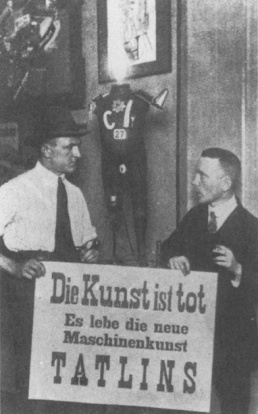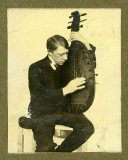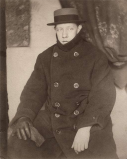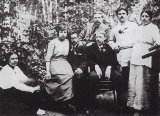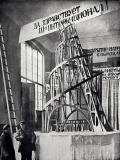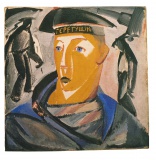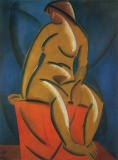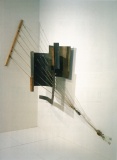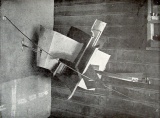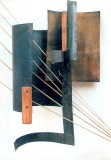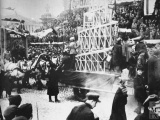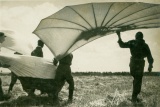Difference between revisions of "Vladimir Tatlin"
| Line 1: | Line 1: | ||
{{Infobox artist | {{Infobox artist | ||
| − | |image = | + | |image = Vladimir_Tatlin_in_front_of_the_model_of_the_monument_to_the_Third_International_Petrograd_1920.jpg |
|imagesize = 250px | |imagesize = 250px | ||
| − | |caption = | + | |caption = Tatlin in front of the model of the ''Monument to the Third International'', Petrograd, 1920. |
|birth_date = {{birth date|1885|12|28|mf=y}} | |birth_date = {{birth date|1885|12|28|mf=y}} | ||
|birth_place = [[Moscow]], Russian Empire | |birth_place = [[Moscow]], Russian Empire | ||
| Line 8: | Line 8: | ||
|death_place = Moscow, Soviet Union | |death_place = Moscow, Soviet Union | ||
}} | }} | ||
| − | [[Image: | + | [[Image:Tatlin_and_his_assistants_at_work_on_a_model_for_the_Monument_to_the_Third_International_1920.jpg|thumb|258px|Tatlin (centre) and his assistants at work on a model for the ''Monument to the Third International'', 1920.]] |
| − | [[Image: | + | [[Image:Art_is_Dead_Long_live_Tatlins_New_Machine_Art_1920.jpg|thumb|258px|First International Dada Fair, Otto Burchard Gallery, Berlin, 1920: "Art is Dead - Long live Tatlin’s New Machine Art".]] |
'''Vladimir''' Yevgraphovich '''Tatlin''' (Russian: Влади́мир Евгра́фович Та́тлин December 28, 1885 – May 31, 1953) Painter and architect. | '''Vladimir''' Yevgraphovich '''Tatlin''' (Russian: Влади́мир Евгра́фович Та́тлин December 28, 1885 – May 31, 1953) Painter and architect. | ||
==Life and work== | ==Life and work== | ||
| − | Born 1885 in Kharkiv, Ukraine, Russian Empire, to a railway engineer and a poet. | + | Born 1885 in Kharkiv, Ukraine, Russian Empire, to a railway engineer and a poet. He ran away from home and joined the Merchant Marine, worked as a merchant sea cadet; continued to go to sea intermittently until 1914-15. Spent some time abroad. |
| − | + | Began his art career as an icon painter in Moscow, and ultimately entered the Moscow School of Painting, Sculpture and Architecture; studied under the academic painters K. A. Korovin and V. A. Serov. Also a professional musician-bandurist, and 1906 performed at the Paris World Fair. By 1908 he was a friend of [[Mikhail Larionov]], the [[Burliuk brothers]], the [[Vesnin brothers]], as well as with the painter Lebedev and the sculptor Lebedeva, who would remain lifelong friends. 1909-10 he began exhibiting fairly regularly in the principal avant-garde exhibitions in Odessa, Moscow, and Petrograd; with the [[League of Youth]] in 1911, [[The Donkey's Tail]] in 1912, joined the [[Jack of Diamonds]] in 1912, showed at the ''League of Youth'' and ''World of Art'' exhibitions in 1913, the ''Tramway V'' and ''[[0.10]]'' in 1915, solo exhibition ''The Shop'' in 1916; knew most of the significant artists of the period. 1911 his first stage designs, for ''Czar Maximillian and His Unruly Son Adolf'' in Moscow. 1915 public conflict with [[Kazimir Malevich|Malevich]] over his suprematist works shown at the time of the ''[[0.10]]'' exhibition, also called "the last futurist exhibition", what leads Malevich to develop his ideas further in the city of Vitebsk. Spring-Summer 1913 traveled briefly to Berlin as a bandore player, and subsequently to Paris, where he visited Picasso in his studio, returned to Russia and began producing ''Relief Constructions'' (1913-17), a series of sculptures made from wood, iron and an assortment of junk and other "found" materials for hanging in wall corners. 1917, together with [[Rodchenko|Alexander Rodchenko]], he worked under George Yakulov on the interior decoration of Moscow's Cafe Pittoresque. | |
| − | + | Tatlin's constructions culminated in a commissioned extraordinary model for the ''Monument to the Third International'' (an unfinished wooden prototype), exhibited in Petrograd (now St. Petersburg) in November 1920 and in Moscow in December 1920, and which quickly became a symbol of the Constructivists. The monument was conceived as a working building, an enormous skeletal apparatus a third higher than the Eiffel Tower at 1,300 feet high. Inside the iron-and-steel structure of twin spirals, the design envisaged three building blocks intended to house the executive, administrative and propaganda offices of the Comintern, covered with glass windows, which would rotate at different speeds (the first one, a cube, once a year; the second one, a pyramid, once a month; the third one, a cylinder, once a day). Resembling a huge functioning machine made of iron beams and glass, the tower demonstrated the power of the machine aesthetic as a symbol of revolutionary objectives. Tatlin declared that he was restoring the essential unity of painting, sculpture and architecture, "combining purely artistic forms with utilitarian intentions.. The fruits of this are models which give rise to discoveries serving the creation of a new world and which call upon producers to control the forms of the new everyday life" (Bann, p 14). High prices prevented the execution of the model. | |
| − | Since 1918 involved with pedagogy, reorganizing the curriculum of the State Free Art Studios, and teaching 'Volume, Material, and Construction' (1919-24), 'Culture of Materials' (1921-25), and wood- and metalworking and ceramics (1927-30). 1922 appointed the head of the woodworking studio. | + | Since 1918 involved with pedagogy, reorganizing the curriculum of the State Free Art Studios, and teaching 'Volume, Material, and Construction' (1919-24), 'Culture of Materials' (1921-25), and wood- and metalworking and ceramics (1927-30). 1922 appointed the head of the woodworking studio. Continued to work on stage decors until his death. |
| − | His glider ''Letatlin'' | + | His glider ''Letatlin'' was assembled in 1930-32 in the tower of the Novodevichy Monastery in Moscow with students from the [[Vkhutein]]. |
| − | + | Tatlin made stringed musical instruments throughout his lifetime. Towards the end of his life he started to research bird flight. Died 1953. | |
| + | |||
| + | Tatlin's Tower was reconstructed on several occasions: in Sweden (1968), United Kingdom (1971, [http://www.royalacademy.org.uk/ra-magazine/autumn-2011/tower-of-strength,295,RAMA.html 2011]), Russia (by T. Shapiro, 1975, 1980; by D. Dimakov, N. Debrin, I. Fedotov and E. Lapshina, 1986-91), France (1979), and the United States (1980, 1983). | ||
| + | |||
| + | ==Portraits== | ||
| + | <gallery> | ||
| + | Vladimir_Tatlin_1911.jpg|In 1911. | ||
| + | Tatlin_with_bandura.jpg|With bandura, 1912. | ||
| + | Tatlin_in_Paris_1914.png|In Paris, 1914. | ||
| + | Vladimir_Tatlin_1914_or_1915.jpg|c1914-15. | ||
| + | Tatlin_Kliun_Malevich_Rafalovich_in_Nemchinovka_c1915.jpg|Tatlin (centre right), Ivan Kliun (behind him), Malevich and his second wife Sofia Rafalovich (on the right) at Malevich's summer residence in Nemchinovka near Moscow, c1915. | ||
| + | Vladimir_Tatlin_wearing_a_coat_of_his_own_design_and_standing_next_to_an_energy_efficient_stove_he_designed_ca_1919.jpg|Tatlin wearing a coat of his own design, and standing next to an energy efficient stove he designed, c1919. | ||
| + | Vladimir_Tatlin_building_Monument_to_the_Third_International.jpg|Tatlin photographed building the ''Monument to the Third International''. | ||
| + | Tatlin_Vladimir_Model_of_the_Monument_to_the_Third_International.jpg|Tatlin with his assistant in front of a model for the ''Monument to the Third International'', Petrograd, 1920. | ||
| + | </gallery> | ||
==Works== | ==Works== | ||
<gallery> | <gallery> | ||
| − | + | Tatlin_Vladimir_1911_Sailor_self-portrait.jpg|''Sailor'' (self-portrait), 1911. | |
| − | + | Tatlin_Vladimir_1912-14_Sketch_for_stage_set_Glinkas_Ivan_Susanin.jpg|Sketch for stage set, Glinka's ''Ivan Susanin'', 1912-14. | |
| − | + | Tatlin_Vladimir_1913_composition_with_female_nude.jpg|Composition with female nude, 1913. | |
| − | + | Tatlin_Vladimir_1914_Relief.jpg|''Relief'', 1914. | |
| − | + | Tatlin_Vladimir_1914_Counter_Relief_2.jpg|''Counter Relief'', 1914. | |
| + | Tatlin_Vladimir_1914_Counter_Relief.jpg|''Counter Relief'', 1914. | ||
| + | Tatlin_Vladimir_1915_Corner_Relief.jpg|''Corner Relief'', 1915. | ||
| + | Tatlin_Vladimir_1915_Corner_Counter_Relief_detail.jpg|''Corner Counter Relief'', detail, 1915. | ||
| + | A_model_of_Tatlins_Tower_on_parade_1_May_1925.jpg|The model of Tatlin's ''Tower'', being used in demonstration, 1 May 1925. | ||
| + | Presentation_of_Vladimir_Tatlins_Letatlin.jpg|Presentation of Vladimir Tatlin’s Letatlin. | ||
</gallery> | </gallery> | ||
==Literature== | ==Literature== | ||
| + | [[Image:Punin_Nikolay_Pamyatnik_III_internatsionala.jpg|thumb|258px|Nikolay Punin, ''Pamyatnik III internatsionala. Proyekt khud. E. Tatlina'', 1920. [[Media:Punin_Nikolay_Pamyatnik_III_internatsionala_Proyekt_khud_E_Tatlina.pdf|Download]].]] | ||
| + | ; Monographs and pamphlets on Tatlin | ||
* Nikolay Punin, ''[http://monoskop.org/log/?p=10274 Pamyatnik III internatsionala. Proyekt khud. E. Tatlina]'' [Памятник III интернационала. Проект худ. Е. Татлина], St. Petersburg [Петроград]: Otdel IZO Narkompros [Отд. изобразительных искусств Н.К.П; Department of Visual Arts of Narkompros], 1920, 7 pp. (in Russian). [http://biblio-comintern.narod.ru/cominternproektpamyatnik1920.doc Text], [http://leb.nlr.ru/edoc/314251/], [http://digital.wolfsonian.org/WOLF007594/00001] | * Nikolay Punin, ''[http://monoskop.org/log/?p=10274 Pamyatnik III internatsionala. Proyekt khud. E. Tatlina]'' [Памятник III интернационала. Проект худ. Е. Татлина], St. Petersburg [Петроград]: Otdel IZO Narkompros [Отд. изобразительных искусств Н.К.П; Department of Visual Arts of Narkompros], 1920, 7 pp. (in Russian). [http://biblio-comintern.narod.ru/cominternproektpamyatnik1920.doc Text], [http://leb.nlr.ru/edoc/314251/], [http://digital.wolfsonian.org/WOLF007594/00001] | ||
** [[Media:Punin_Nikolai_1920_1992_The_Monument_to_the_Third_International.pdf|"The Monument to the Third International"]], trans. Christina Lodder, in ''Art in Theory, 1900-1990: An Anthology of Changing Ideas'', eds. Charles Harrison and Paul Wood, 1992, pp 311-315. | ** [[Media:Punin_Nikolai_1920_1992_The_Monument_to_the_Third_International.pdf|"The Monument to the Third International"]], trans. Christina Lodder, in ''Art in Theory, 1900-1990: An Anthology of Changing Ideas'', eds. Charles Harrison and Paul Wood, 1992, pp 311-315. | ||
* Nikolay Punin, ''Tatlin: Protiv kubizma'' [Татлин: Против кубизма], St. Petersburg: Gos. izd-vo, 1921, 25 pp. (in Russian) | * Nikolay Punin, ''Tatlin: Protiv kubizma'' [Татлин: Против кубизма], St. Petersburg: Gos. izd-vo, 1921, 25 pp. (in Russian) | ||
| − | * А. | + | * Guy Davenport, ''[http://lib.rus.ec/b/390178/read Татлин!]'', trans. Maxim Nemtsov, 1974. (in Russian) |
| + | * John Milner, ''Vladimir Tatlin and the Russian Avant-Garde'', New Haven: Yale University Press, 1983. | ||
| + | * Larissa A. Zhadova (ed.), ''Tatlin'', New York: Rizzoli, 1988. [http://www.jstor.org/stable/309335 Review]. | ||
| + | * Anatoly Strigalev, Jürgen Harten (eds.), ''Vladimir Tatlin: Leben, Werk, Wirkung: Eine internationales Symposium'', Cologne: DuMont, 1993, 416 pp. (in German) | ||
| + | * V. Rakitin (В. Ракитин), A. Sarabyanov (А. Сарабьянов) (eds.), ''N. Punin o Tatline'' [Н. Пунин о Татлине], Moscow: RA, 2001. (in Russian) | ||
| + | * Norbert Lynton, ''Tatlin's Tower: Monument to Revolution'', New Haven: Yale University Press, 2009. | ||
| + | |||
| + | ; Catalogues | ||
| + | * ''Vystavka rabot zasluzhennogo deiatelia iskusstv V. E Tatlina'', Moscow and Leningrad: Ogiz-Izogis, 1932. (in Russian) | ||
* Troels Andersen (ed.), ''Vladimir Tatlin'', Stockholm: Moderna museet, 1968, 92 pp. Catalogue. (in English/Swedish) | * Troels Andersen (ed.), ''Vladimir Tatlin'', Stockholm: Moderna museet, 1968, 92 pp. Catalogue. (in English/Swedish) | ||
| − | * | + | * Andrei B. Nakov, ''Tatlin's Dream: Russian Suprematist and Constructivist Art, 1910-1923'', London: Fischer Fine Art, 1974. Catalogue. |
| − | * | + | * Lutz Becker (ed.), ''Construction: Tatlin and After'', Thessaloniki: State Museum of Contemporary Art, Costakis Collection, 2001. |
| + | * ''[http://media.wix.com/ugd/23892f_4d67a9d57c7de3ef9d8b062d53c46585.pdf Beskonechnaya Tatlin chasha velikogo...]'', Moscow: Tretyakov Gallery and Sepherot Foundation, 2011, 12 pp. [http://www.tretyakovgallery.ru/ru/calendar/exhibitions/exhibitions2334/ Exhibition] | ||
| + | * Museum Tinguely, Basel (ed.), ''Tatlin: neue Kunst fur eine neue Welt / Tatlin novoe iskusstvo dlya noogo mira / Tatlin: New Art for a New World'', Hatje Cantz, 2012. (in German/Russian/English). [http://www.tinguely.ch/en/ausstellungen_events/austellungen/2012/Tatlin.html Exhibition]. | ||
| + | ** [http://www1.wsws.org/articles/2012/jun2012/tat1-j19.shtml Six articles devoted to the exhibition]: [http://www1.wsws.org/articles/2012/jun2012/tat2-j20.shtml Interview with Roland Wetzel], [http://www1.wsws.org/articles/2012/jun2012/tat3-j21.shtml David Walsh on Tatlin], [http://www1.wsws.org/articles/2012/jun2012/tat4-j25.shtml Interview with Dmitrii Dimakov], [http://www1.wsws.org/articles/2012/jun2012/tat5-j28.shtml Interview with Gian Casper Bott], [http://www1.wsws.org/articles/2012/jun2012/tat6-j30.shtml Interview with Anna Szech]. | ||
| + | |||
| + | ; Book chapters, Papers and Articles on Tatlin | ||
| + | * Victor Shklovsky, "Pamiatnik tret’emu internatsionalu", in ''Khod konia'', Moscow and Berlin: Gelikon, 1923, pp 108-111. | ||
| + | * А. Абрамова, "Татлин", ''Декоративное искусство СССР'' 2, 1966, pp 5-7. (in Russian) | ||
* ''V. E. Tatlin: katalog vystavki proizvedenii'', Moscow: Sovetskaia khudozhnikov, 1977, 68 pp. Catalogue. (in Russian) | * ''V. E. Tatlin: katalog vystavki proizvedenii'', Moscow: Sovetskaia khudozhnikov, 1977, 68 pp. Catalogue. (in Russian) | ||
* Margit Rowell, [[Media:Rowell_Margit_1978_Vladimir_Tatlin_Form_Faktura.pdf|"Vladimir Tatlin: Form/Faktura"]], ''October'' 7 (Winter 1978), pp 83-108. | * Margit Rowell, [[Media:Rowell_Margit_1978_Vladimir_Tatlin_Form_Faktura.pdf|"Vladimir Tatlin: Form/Faktura"]], ''October'' 7 (Winter 1978), pp 83-108. | ||
* А. Раппапорт, [http://papardes.blogspot.com/2009/10/blog-post_15.html "К пониманию контррельефов Татлина"], ''Wiener Slawistische almanach'', 1982. | * А. Раппапорт, [http://papardes.blogspot.com/2009/10/blog-post_15.html "К пониманию контррельефов Татлина"], ''Wiener Slawistische almanach'', 1982. | ||
| − | |||
| − | |||
| − | |||
| − | |||
| − | |||
* ''Von Kandinsky bis Tatlin: Konstruktivismus in Europa/From Kandinsky to Tatlin: Constructivism in Europe'', Schwerin: Staatliches Museum; and Bonn: Kunstmuseum, 2006. (in German/English) | * ''Von Kandinsky bis Tatlin: Konstruktivismus in Europa/From Kandinsky to Tatlin: Constructivism in Europe'', Schwerin: Staatliches Museum; and Bonn: Kunstmuseum, 2006. (in German/English) | ||
| − | |||
| − | |||
* Gabriel Villalobos, [http://www.academia.edu/3676987 "A New Palpable World: The Counter-Reliefs of Vladimir Tatlin"], 2012. | * Gabriel Villalobos, [http://www.academia.edu/3676987 "A New Palpable World: The Counter-Reliefs of Vladimir Tatlin"], 2012. | ||
| − | * http:// | + | * Svetlana Boym, [http://www.cabinetmagazine.org/issues/28/boym2.php "Tatlin, or, Ruinophilia"], ''Cabinet'' 28 (Winter 2007/08). |
| + | |||
| + | ; Theses | ||
| + | * Olga Zibrova (Ольга Зиброва), ''Pozdnee tvorchestvo V.E. Tatlin'' [Позднее творчество В.Е. Татлина], St. Petersburg, 2009, 335 pp. Ph.D. Dissertation. [http://www.dissercat.com/content/pozdnee-tvorchestvo-ve-tatlina] [http://leb.nlr.ru/edoc/338931/] | ||
==See also== | ==See also== | ||
| Line 63: | Line 95: | ||
* [http://oxfordindex.oup.com/view/10.1093/oi/authority.20110803102214200 Tatlin at Oxford Index] | * [http://oxfordindex.oup.com/view/10.1093/oi/authority.20110803102214200 Tatlin at Oxford Index] | ||
* http://www.artexpertswebsite.com/pages/artists/tatlin.php | * http://www.artexpertswebsite.com/pages/artists/tatlin.php | ||
| + | * [http://www.rgali.ru/object/10905284?lc=en Tatlin at the Russian State Archive of Literature and Art] | ||
| + | * [http://www.maslovka.org/modules.php?name=Content&pa=showpage&pid=131 Three biographies and a selection of works of Tatlin] (in Russian) | ||
| + | * [http://www.tretyakovgallery.ru/ru/collection/_show/author/_id/148 Tatlin at Tretyakov Gallery] | ||
{{featured_article}} | {{featured_article}} | ||
{{DEFAULTSORT:Tatlin, Vladimir}} | {{DEFAULTSORT:Tatlin, Vladimir}} | ||
| − | |||
| − | |||
| − | |||
Revision as of 13:07, 30 January 2014
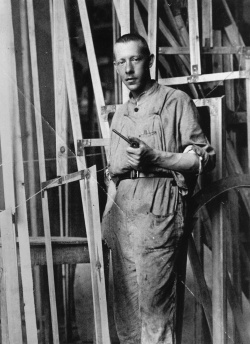 Tatlin in front of the model of the Monument to the Third International, Petrograd, 1920. | |
| Born |
December 28, 1885 Moscow, Russian Empire |
|---|---|
| Died |
May 31, 1953 (aged 67) Moscow, Soviet Union |
Vladimir Yevgraphovich Tatlin (Russian: Влади́мир Евгра́фович Та́тлин December 28, 1885 – May 31, 1953) Painter and architect.
Life and work
Born 1885 in Kharkiv, Ukraine, Russian Empire, to a railway engineer and a poet. He ran away from home and joined the Merchant Marine, worked as a merchant sea cadet; continued to go to sea intermittently until 1914-15. Spent some time abroad.
Began his art career as an icon painter in Moscow, and ultimately entered the Moscow School of Painting, Sculpture and Architecture; studied under the academic painters K. A. Korovin and V. A. Serov. Also a professional musician-bandurist, and 1906 performed at the Paris World Fair. By 1908 he was a friend of Mikhail Larionov, the Burliuk brothers, the Vesnin brothers, as well as with the painter Lebedev and the sculptor Lebedeva, who would remain lifelong friends. 1909-10 he began exhibiting fairly regularly in the principal avant-garde exhibitions in Odessa, Moscow, and Petrograd; with the League of Youth in 1911, The Donkey's Tail in 1912, joined the Jack of Diamonds in 1912, showed at the League of Youth and World of Art exhibitions in 1913, the Tramway V and 0.10 in 1915, solo exhibition The Shop in 1916; knew most of the significant artists of the period. 1911 his first stage designs, for Czar Maximillian and His Unruly Son Adolf in Moscow. 1915 public conflict with Malevich over his suprematist works shown at the time of the 0.10 exhibition, also called "the last futurist exhibition", what leads Malevich to develop his ideas further in the city of Vitebsk. Spring-Summer 1913 traveled briefly to Berlin as a bandore player, and subsequently to Paris, where he visited Picasso in his studio, returned to Russia and began producing Relief Constructions (1913-17), a series of sculptures made from wood, iron and an assortment of junk and other "found" materials for hanging in wall corners. 1917, together with Alexander Rodchenko, he worked under George Yakulov on the interior decoration of Moscow's Cafe Pittoresque.
Tatlin's constructions culminated in a commissioned extraordinary model for the Monument to the Third International (an unfinished wooden prototype), exhibited in Petrograd (now St. Petersburg) in November 1920 and in Moscow in December 1920, and which quickly became a symbol of the Constructivists. The monument was conceived as a working building, an enormous skeletal apparatus a third higher than the Eiffel Tower at 1,300 feet high. Inside the iron-and-steel structure of twin spirals, the design envisaged three building blocks intended to house the executive, administrative and propaganda offices of the Comintern, covered with glass windows, which would rotate at different speeds (the first one, a cube, once a year; the second one, a pyramid, once a month; the third one, a cylinder, once a day). Resembling a huge functioning machine made of iron beams and glass, the tower demonstrated the power of the machine aesthetic as a symbol of revolutionary objectives. Tatlin declared that he was restoring the essential unity of painting, sculpture and architecture, "combining purely artistic forms with utilitarian intentions.. The fruits of this are models which give rise to discoveries serving the creation of a new world and which call upon producers to control the forms of the new everyday life" (Bann, p 14). High prices prevented the execution of the model.
Since 1918 involved with pedagogy, reorganizing the curriculum of the State Free Art Studios, and teaching 'Volume, Material, and Construction' (1919-24), 'Culture of Materials' (1921-25), and wood- and metalworking and ceramics (1927-30). 1922 appointed the head of the woodworking studio. Continued to work on stage decors until his death.
His glider Letatlin was assembled in 1930-32 in the tower of the Novodevichy Monastery in Moscow with students from the Vkhutein.
Tatlin made stringed musical instruments throughout his lifetime. Towards the end of his life he started to research bird flight. Died 1953.
Tatlin's Tower was reconstructed on several occasions: in Sweden (1968), United Kingdom (1971, 2011), Russia (by T. Shapiro, 1975, 1980; by D. Dimakov, N. Debrin, I. Fedotov and E. Lapshina, 1986-91), France (1979), and the United States (1980, 1983).
Portraits
Works
Literature
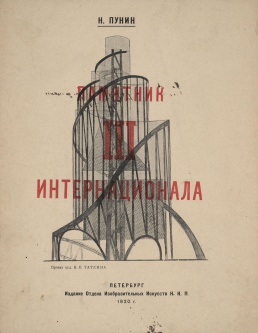
- Monographs and pamphlets on Tatlin
- Nikolay Punin, Pamyatnik III internatsionala. Proyekt khud. E. Tatlina [Памятник III интернационала. Проект худ. Е. Татлина], St. Petersburg [Петроград]: Otdel IZO Narkompros [Отд. изобразительных искусств Н.К.П; Department of Visual Arts of Narkompros], 1920, 7 pp. (in Russian). Text, [1], [2]
- "The Monument to the Third International", trans. Christina Lodder, in Art in Theory, 1900-1990: An Anthology of Changing Ideas, eds. Charles Harrison and Paul Wood, 1992, pp 311-315.
- Nikolay Punin, Tatlin: Protiv kubizma [Татлин: Против кубизма], St. Petersburg: Gos. izd-vo, 1921, 25 pp. (in Russian)
- Guy Davenport, Татлин!, trans. Maxim Nemtsov, 1974. (in Russian)
- John Milner, Vladimir Tatlin and the Russian Avant-Garde, New Haven: Yale University Press, 1983.
- Larissa A. Zhadova (ed.), Tatlin, New York: Rizzoli, 1988. Review.
- Anatoly Strigalev, Jürgen Harten (eds.), Vladimir Tatlin: Leben, Werk, Wirkung: Eine internationales Symposium, Cologne: DuMont, 1993, 416 pp. (in German)
- V. Rakitin (В. Ракитин), A. Sarabyanov (А. Сарабьянов) (eds.), N. Punin o Tatline [Н. Пунин о Татлине], Moscow: RA, 2001. (in Russian)
- Norbert Lynton, Tatlin's Tower: Monument to Revolution, New Haven: Yale University Press, 2009.
- Catalogues
- Vystavka rabot zasluzhennogo deiatelia iskusstv V. E Tatlina, Moscow and Leningrad: Ogiz-Izogis, 1932. (in Russian)
- Troels Andersen (ed.), Vladimir Tatlin, Stockholm: Moderna museet, 1968, 92 pp. Catalogue. (in English/Swedish)
- Andrei B. Nakov, Tatlin's Dream: Russian Suprematist and Constructivist Art, 1910-1923, London: Fischer Fine Art, 1974. Catalogue.
- Lutz Becker (ed.), Construction: Tatlin and After, Thessaloniki: State Museum of Contemporary Art, Costakis Collection, 2001.
- Beskonechnaya Tatlin chasha velikogo..., Moscow: Tretyakov Gallery and Sepherot Foundation, 2011, 12 pp. Exhibition
- Museum Tinguely, Basel (ed.), Tatlin: neue Kunst fur eine neue Welt / Tatlin novoe iskusstvo dlya noogo mira / Tatlin: New Art for a New World, Hatje Cantz, 2012. (in German/Russian/English). Exhibition.
- Book chapters, Papers and Articles on Tatlin
- Victor Shklovsky, "Pamiatnik tret’emu internatsionalu", in Khod konia, Moscow and Berlin: Gelikon, 1923, pp 108-111.
- А. Абрамова, "Татлин", Декоративное искусство СССР 2, 1966, pp 5-7. (in Russian)
- V. E. Tatlin: katalog vystavki proizvedenii, Moscow: Sovetskaia khudozhnikov, 1977, 68 pp. Catalogue. (in Russian)
- Margit Rowell, "Vladimir Tatlin: Form/Faktura", October 7 (Winter 1978), pp 83-108.
- А. Раппапорт, "К пониманию контррельефов Татлина", Wiener Slawistische almanach, 1982.
- Von Kandinsky bis Tatlin: Konstruktivismus in Europa/From Kandinsky to Tatlin: Constructivism in Europe, Schwerin: Staatliches Museum; and Bonn: Kunstmuseum, 2006. (in German/English)
- Gabriel Villalobos, "A New Palpable World: The Counter-Reliefs of Vladimir Tatlin", 2012.
- Svetlana Boym, "Tatlin, or, Ruinophilia", Cabinet 28 (Winter 2007/08).
- Theses
- Olga Zibrova (Ольга Зиброва), Pozdnee tvorchestvo V.E. Tatlin [Позднее творчество В.Е. Татлина], St. Petersburg, 2009, 335 pp. Ph.D. Dissertation. [3] [4]

